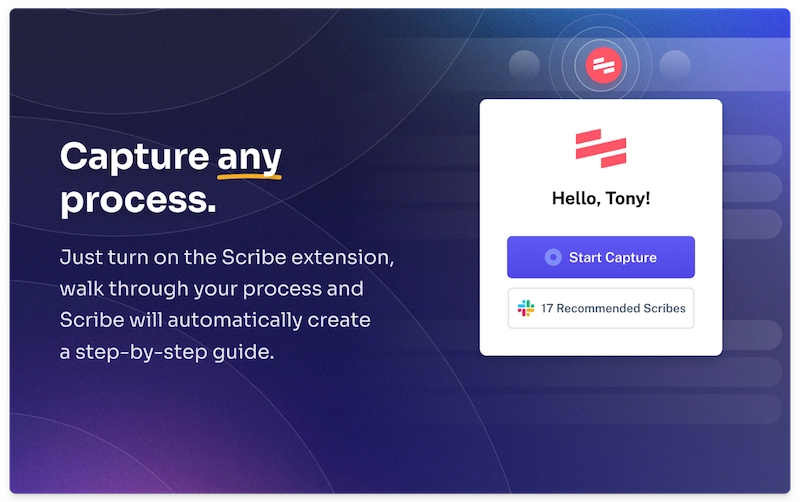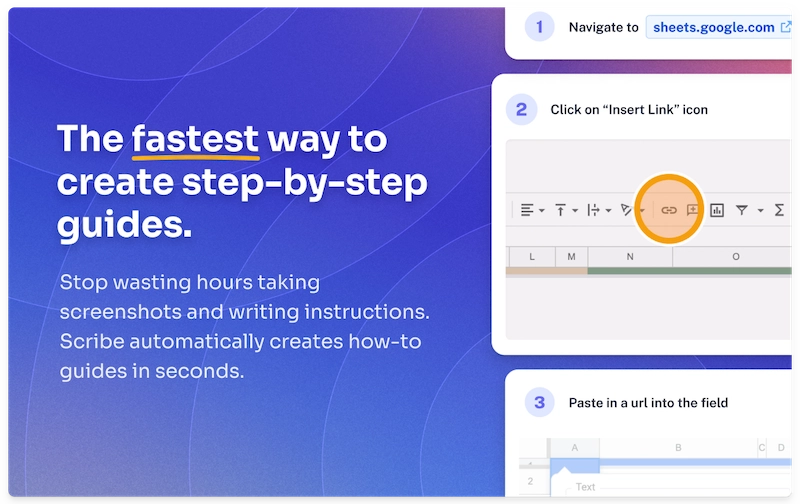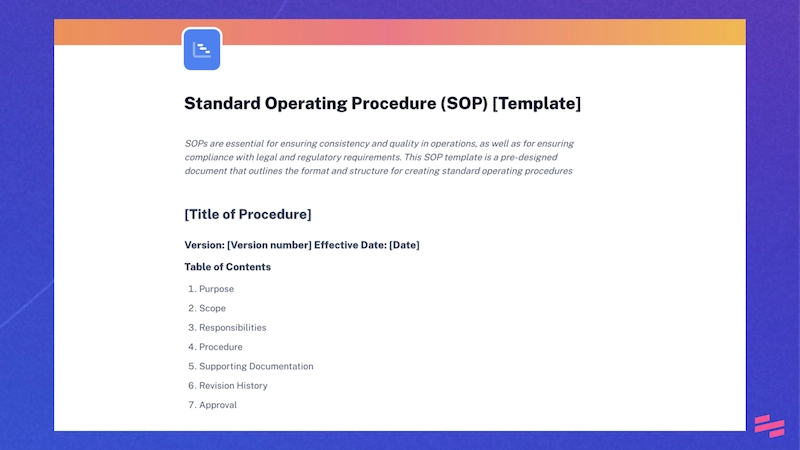Introduction

Only two percent of organizations have all their internal processes modeled and documented. Apparently, the other 98 percent don't want to enjoy the benefits of process standardization.
… Or they don’t know how to seize the growth opportunities through effective documentation. If that’s the case for you, we’re here to help.
In this article, you'll find some of the most significant benefits of sharing step-by-step instructions within an organization, with several step-by-step guide templates that you can use and share with your team.
What is a step-by-step guide?
A step-by-step guide is a detailed walkthrough of a process broken down into tasks. It can be used to teach people how to do anything from building a website to cooking a meal.
Step-by-step guides can be internal and external. Internal tutorials establish particular ways of performing specific processes and procedures (a.k.a standard operating procedures or SOPs) and transfer this knowledge between employees.
The target audience of external tutorials is the organization’s prospects or customers. This type of guidance offers walkthroughs and best practices to help users make the most of a product, service, or tool.
Depending on the complexity of the workflow, step-by-step guides may include screenshots, videos, gifs, examples, or any other elements that add clarity.
Step-by-step guide template benefits
Step-by-step guides form a strong base for successful business operations. They standardize internal processes by outlining employees' key steps to reach the desired objective.
These are some tangible benefits of creating easy-to-follow how-to guides for your teams:
1. Consistency and standardization
Establishing consistent processes is the key to enhancing employee performance and achieving the organization’s operational goals.
Step-by-step guides break down complex processes into simple and actionable steps, establishing a standardized method that all employees can follow.
2. Time and money savings
Employees spend 20 percent of the workweek looking for help with specific tasks. Having how-to guides at hand can help teams spend this time more productively.
And as far as budget, enterprises waste from $2.5 to $3.5 million per year as a result of the lack of knowledge sharing.
Process documentation is one of the most effective ways to transfer institutional knowledge and address the knowledge-sharing problem.
3. Improved knowledge-sharing
By creating and promoting step-by-step guides, you give employees access to the team's collective expertise. This fosters a culture of continuous learning and empowers individuals to acquire new skills and knowledge.
4. Higher levels of collaboration
Fifty-four percent of respondents consider improved employee collaboration the biggest benefit of digital documentation.
Standardized procedures and approaches ensure that all team members are on the same page, reducing misunderstandings and promoting smooth cooperation.
Sadly, the average employee spends 5.3 hours per week waiting for assistance or insights from colleagues. When having step-by-step guides in place, one can always share relevant links with anyone in need of guidance instead of providing in-person assistance.
This saves time and empowers individuals to take ownership of their tasks and problem-solving.
4. Streamlined onboarding experience
Incorporating step-by-step tutorials into the onboarding course significantly improves the experience for new hires.
Ready-to-use step-by-step guides save people managers’ time and introduce new employees to the information they need to do their work successfully.
Use Infographics and clear instructions in your step-by-step guides to simplify the learning process, helping employees grasp new concepts and achieve efficiency faster.
5. Increased productivity and engagement
The studies prove that knowledge sharing affects employee engagement. Indeed, 81 percent of employees feel frustrated when they can't access the information they need to do their job.
Unshared knowledge forces employees to spend time recreating their coworkers’ existing expertise or just delay the work in question. All of these result in project delays which can be eliminated with process standardization.
With clear instructions available on demand, employees spend less time searching for the necessary information and feel empowered to be proactive at work.
6. Enhanced quality control & fewer errors
Failure to follow proper procedures is a major cause of daily mistakes in organizations, making up 45 percent of total errors.
This way, by creating and distributing how-to guides outlining the key business processes, you can prevent up to 45 percent of errors caused by improper procedures
Step-by-step guides help address quality control challenges and minimize errors within an organization.
When following standardized processes, employees can achieve consistent and error-free outputs, maintaining high standards and accomplishing excellence in the organization's operations.
How to create a step-by-step guide
Make step-by-step guides to standardize repeatable tasks.
One of the best ways to get started is to use a template or process documentation tool.

Scribe is an AI-powered tool that documents any process for you. Make and visual step-by-step guides in seconds.
Generate step-by-step guides for free. ➜
Want to build step-by-step instructions from scratch? Here's how to get started.

Step 1: Identify the problem(s)
When you get to process standardization, you don’t reinvent the wheel. You just need to document steps you’ve been taking regularly for a long (or not so long) time. But before you do it, you should also define which processes should be documented in the first place.
Talk to the team and the leaders to learn about their day-to-day activities. Start with identifying generic topics (e.g., sales prospecting) and then get more specific (e.g., sales prospecting on LinkedIn). Generic topics will form clusters; more specific processes will be outlined in separate guides under those clusters.
If you work on customer-facing guides, turn to customer data to reveal common pain points, challenges and frequently asked questions. Your product experience data and customer service reports will provide you with plenty of valuable insights.
Step 2: Define the audience
Is the future guide more of an onboarding resource, or should it help senior employees to address roadblocks? Is it intended for one specific team, or will the entire company use it?
The answers will indicate whether you need to explain the terminology, introduce readers to the tools and provide a wider context. Knowing in advance which personas will use your guide helps to speak their language without overcomplicating or oversimplifying things.
Step 3: Pick the software
Automating process documentation allows you to save precious time and reduces the possibility of spreading inaccurate information. It’s easy to miss critical information when dealing with complex, multi-step processes.
SOP tools like Scribe will automatically create visual step-by-step guides while you carry out the processes that you want to capture.
Step 4: Outline the steps
If you choose to create how-to guides manually or need to document the process that can’t be captured automatically (for instance, you might want to share a guide to cold calling), you should draft the key steps of the process first.
You can order the steps later – the most important task at this point is to define the milestones to hit along the way.
Step 5: Write up the guide
Now that you have drafted a structure, you can order the steps, add subheadings and support the process document with visuals. Having the written steps outlined first will help you greatly in deciding which visual components your guide needs.
In case you use software, it’s also a moment when you can adjust the guide that has been automatically generated. Add tips and notes enabling readers to perform the process more effectively and troubleshoot if necessary.
You don’t need to add much copy. Just make sure you include enough illustrations supporting the points you make.
Step 7: Update regularly
Once you’ve started to build process documentation, you’re never done with it. If you fail to update the guides as you develop new processes or update the existing ones, you’ll end up with a collection of manuals nobody uses.
To keep your how-to guides up to date, allocate some time monthly or quarterly to check in and make adjustments.
15+ Free step-by-step guide templates
There are countless applications of step-by-step instructions in business. These guides help you work faster while upskilling your clients or colleagues.
1. Create a how-to guide
Scribe is an AI-powered tool that documents your processes for you. Turn your unique workflows into visual how-to guides with text, links and annotated screenshots.
Customize and share step-by-step guides — without having to write a word.
Scribe follows along while you work to capture your screen and build a document in seconds.

2. Standard step-by-step guide template
Here's an every-day step-by-step guide template so you can build clear and concise instructions for any task or process.
Having a well-structured step-by-step guide helps users to quickly and easily complete tasks, increasing efficiency and reducing the chance of errors.

This step-by-step guide template includes:
- Author and publishing info.
- An Intro and overview.
- A breakdown of process steps.
3. Standard operating procedure (SOP) step-by-step guide template

SOPs help companies maintain operational consistency and quality, and maintain compliance. These are perfect for highly regulated industries like finance, manufacturing and healthcare.
An SOP template is a pre-designed document that outlines the format and structure for creating standard operating procedures.
This template standard operating procedure template includes a(n):
- Table of contents.
- Purpose.
- Scope.
- Responsibilities.
- Procedures.
- Supporting documentation.
- Revision history.
Use this template to save time and resources while ensuring that your SOPs are clear, concise and consistent.
4. New-hire training step-by-step guide template

The most common use case for step-by-step instructions is employee onboarding and training. HR reps and people managers create detailed guides for new hires to follow when they join the organization.
This training template includes a(n):
- Table of contents.
- Introduction.
- Orientation (including business documentation)
- Training breakdown.
- Assessments.
- Resources.
- Evaluation.
Training Step-by-step guides bring the opportunity to replace in-person lessons and one-on-one guidance, allowing organizations to scale hiring and onboarding without disturbing senior employees.
These how-to guides usually include role-specific training, an introduction to company culture and a presentation of internal processes and procedures.
More free step-by-step guide templates
Here are more of the most popular how-to guide templates for different teams
5. Customer onboarding how-to guide template

Every company should provide their clients or customers with helpful resources that provide clear directions and tutorials on how to get started with the product or service.
These onboarding manuals usually cover a range of topics for customers at all levels, from the very basics for beginners (e.g. “how to create your Salesforce account”) to more advanced workflows (e.g. “how to create Salesforce automation rules”) for high-level professionals.
Software companies often include product functionality walkthroughs and advice for resolving problems, a.k.a. troubleshooting guides.
6. Customer service SOP template

Step-by-step guides are essential tools to improve efficiency and customer satisfaction. By creating a catalog of common customer problems and corresponding solutions, customer service teams can quickly identify and follow the best course of action.
The guides may also include advanced techniques for effectively handling customer feedback and resolving confusion.
7. User manual template

Eighty-five percent of employees agree that preserving and sharing unique knowledge in the workplace is critical to increasing productivity.
Businesses often use user manuals to document the most effective approaches and standardize internal processes.
This enables employees to perform tasks most efficiently, increasing overall team productivity.
8. Product training step-by-step guide user template

Introducing new technology to employees requires a lot of time and clear documentation.
According to a recent McKinsey study, most organizations achieve less than one-third of the expected impact from their digital investments.
To drive software adoption, managers create product training step-by-step guides that provide clear directions on installing, setting up and using business software.
9. Training manual template

This comprehensive training manual is designed to help trainers deliver effective training programs. This template includes sections for:
- Pre-training preparation.
- Listing training sessions.
- Training content and resources.
- Post-training evaluations.
Training manuals provide a structured framework that can be customized to fit the specific needs of any training program.
10. Work instructions template

Standardize and simplify the process of creating work instructions for different tasks or activities.
This template includes sections for a brief introduction or overview of the task, a list of materials or equipment needed, step-by-step instructions, safety precautions and any other relevant information.
11. Transition plan template

Facilitate a smooth transition from one stage or phase of a project or process to another.
This step-by-step guide user template typically outlines the steps and procedures that need to be taken during the transition period and provides a clear roadmap for all involved parties.
12. Strategic plan template

This comprehensive step-by-step guide helps you create a roadmap for achieving an organization's long-term goals and objectives.
This strategic plan template offers several sections, including:
- Introduction.
- Mission, Vision and Values.
- SWOT Analysis.
- Goals and Objectives.
- Strategies.
- Processes.
- Monitoring and Evaluation.
13. Workflow step-by-step guide template

This free work instructions template outlines a processes:
- Purpose.
- Scope.
- Responsibilities.
- Equipment and materials.
- Procedures.
... and more. By using this template, teams can ensure that all team members have a clear understanding of the process and the steps involved in completing it.
14. Leadership development plan template

Develop and cultivate your high-potential employees into future leaders.
The program is delivered over a period of six months and focuses on developing skills in communication, team management, strategic thinking, and change management.
15. Software step-by-step guide user template

This software user guide template enables you to help users to get the most out of the software and reduce the number of support requests or issues that may arise.
16. Recruitment plan template

Attract and hire the best candidates for the job while minimizing the time and cost required to fill the position.
Use this free step-by-step guide template ➜
Want more step-by-step guides? Check out our template gallery.
Step-by-step user guide template: FAQ
1. What is the purpose of a step-by-step tutorial?
A step-by-step tutorial provides a structured and systematic approach to guide end-users through a process or task. It offers clear instructions and visuals to help users quickly understand and complete complex procedures.
2. What are the key components of a step-by-step guide?
The critical components of a step-by-step guide are:
- An introduction providing context and suggesting expected outcomes.
- A series of well-organized steps.
- Relevant visuals or infographics.
- A list of suitable materials.
3. How to make a step-by-step guide template
To create a step-by-step guide template, start with a title and introduction, then add placeholders for steps, visuals and descriptions. Use a consistent format and layout to maintain clarity and uniformity throughout the guide.
It’s best to turn to automation software to create and reuse those templates. Many platforms offer user-friendly step-by-step guide templates, simplifying the process of designing and organizing your guide. These tools often come with built-in features for adding visuals, editing content and customizing layouts.
Scribe makes your life easier by offering pre-designed step-by-step guide templates for any use case.
4. What are the mistakes to avoid when making a step-by-step guide?
Creating step-by-step guides is no rocket science, but there are pitfalls that may hinder the effectiveness of the process:
- Using complex language: Use language that is easily understandable to your target audience, regardless of their level of expertise.
- Including too much information: It’s best to split a guide into several manuals if there are too many steps and details to cover.
- Neglecting visuals and examples: Visuals, such as images, diagrams and videos, are crucial for enhancing user comprehension in step-by-step guides. Neglecting them can make the guide dull and less engaging.
- Writing it manually: Automation software speeds up the documentation process and ensures consistency in guide formatting and layout.
5. How can step-by-step instructions be used to improve customer service?
Step-by-step guides empower self-service by providing customers with clear instructions to troubleshoot common issues on their own. All you need to do is to include your step-by-step instructions in the self-service portal, website, or external knowledge base.
Use step-by-step guide templates to work faster
Once you've built and shared your own guides with our step-by-step guide templates — it's time to see your team's productivity skyrocket!
Remember that the launch is only the beginning. Step-by-step guides are living documents that should evolve with your processes.
Want something even faster than a template?
Use a tool like Scribe to capture, edit and share guides in half the time. Got process changes? Simply update the step without having to build a brand-new document.
Create your own guides, without hassle. Generate free step-by-step guides today.











